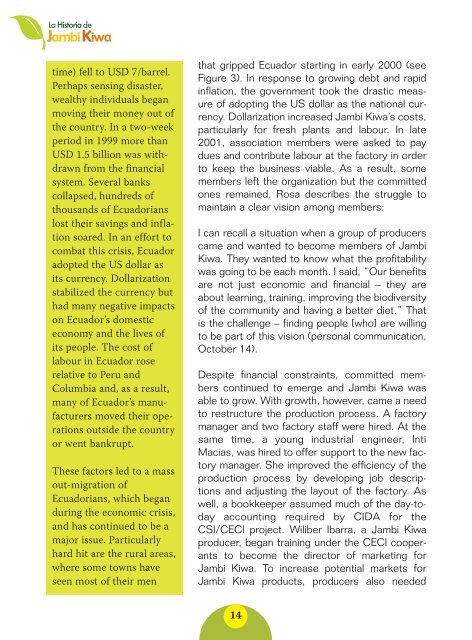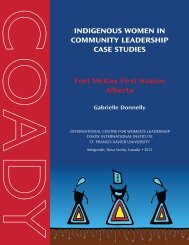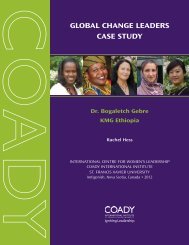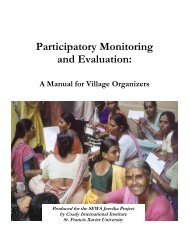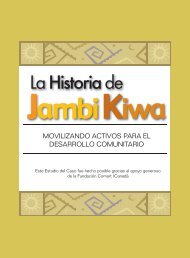Rosa's Story - Coady International Institute - St. Francis Xavier ...
Rosa's Story - Coady International Institute - St. Francis Xavier ...
Rosa's Story - Coady International Institute - St. Francis Xavier ...
Create successful ePaper yourself
Turn your PDF publications into a flip-book with our unique Google optimized e-Paper software.
time) fell to USD 7/barrel.<br />
Perhaps sensing disaster,<br />
wealthy individuals began<br />
moving their money out of<br />
the country. In a two-week<br />
period in 1999 more than<br />
USD 1.5 billion was withdrawn<br />
from the financial<br />
system. Several banks<br />
collapsed, hundreds of<br />
thousands of Ecuadorians<br />
lost their savings and inflation<br />
soared. In an effort to<br />
combat this crisis, Ecuador<br />
adopted the US dollar as<br />
its currency. Dollarization<br />
stabilized the currency but<br />
had many negative impacts<br />
on Ecuador’s domestic<br />
economy and the lives of<br />
its people. The cost of<br />
labour in Ecuador rose<br />
relative to Peru and<br />
Columbia and, as a result,<br />
many of Ecuador’s manufacturers<br />
moved their operations<br />
outside the country<br />
or went bankrupt.<br />
These factors led to a mass<br />
out-migration of<br />
Ecuadorians, which began<br />
during the economic crisis,<br />
and has continued to be a<br />
major issue. Particularly<br />
hard hit are the rural areas,<br />
where some towns have<br />
seen most of their men<br />
that gripped Ecuador starting in early 2000 (see<br />
Figure 3). In response to growing debt and rapid<br />
inflation, the government took the drastic measure<br />
of adopting the US dollar as the national currency.<br />
Dollarization increased Jambi Kiwa’s costs,<br />
particularly for fresh plants and labour. In late<br />
2001, association members were asked to pay<br />
dues and contribute labour at the factory in order<br />
to keep the business viable. As a result, some<br />
members left the organization but the committed<br />
ones remained. Rosa describes the struggle to<br />
maintain a clear vision among members:<br />
I can recall a situation when a group of producers<br />
came and wanted to become members of Jambi<br />
Kiwa. They wanted to know what the profitability<br />
was going to be each month. I said, “Our benefits<br />
are not just economic and financial – they are<br />
about learning, training, improving the biodiversity<br />
of the community and having a better diet.” That<br />
is the challenge – finding people [who] are willing<br />
to be part of this vision (personal communication,<br />
October 14).<br />
Despite financial constraints, committed members<br />
continued to emerge and Jambi Kiwa was<br />
able to grow. With growth, however, came a need<br />
to restructure the production process. A factory<br />
manager and two factory staff were hired. At the<br />
same time, a young industrial engineer, Inti<br />
Macias, was hired to offer support to the new factory<br />
manager. She improved the efficiency of the<br />
production process by developing job descriptions<br />
and adjusting the layout of the factory. As<br />
well, a bookkeeper assumed much of the day-today<br />
accounting required by CIDA for the<br />
CSI/CECI project. Wiliber Ibarra, a Jambi Kiwa<br />
producer, began training under the CECI cooperants<br />
to become the director of marketing for<br />
Jambi Kiwa. To increase potential markets for<br />
Jambi Kiwa products, producers also needed<br />
14


